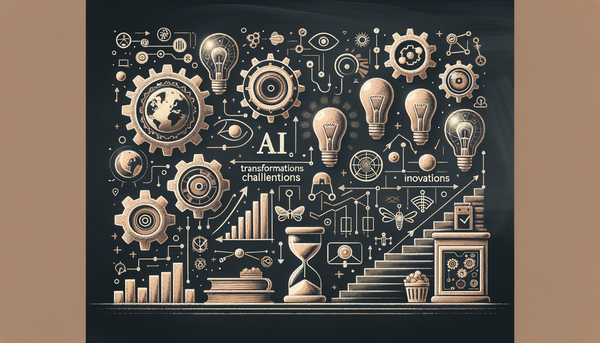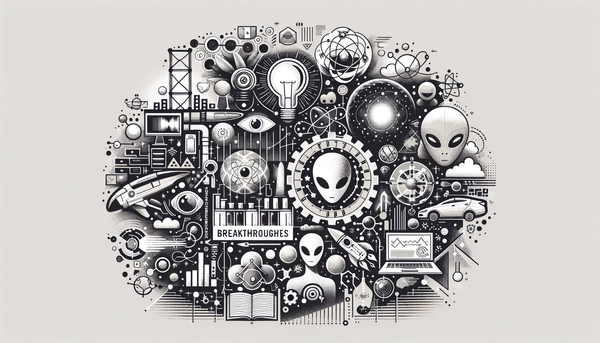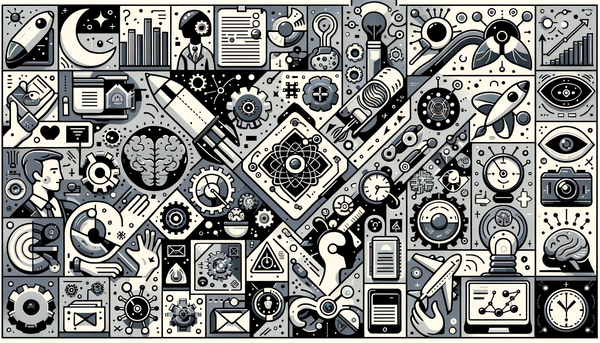The Dark Side of AI: Misuse and Dangers
This in-depth exploration dives into several unfolding narratives in the world of artificial intelligence, examining everything from controversial deepfake ads that blur ethical boundaries to strategic collaborations between tech giants and their implications on consumer technology. We also explore the challenge of balancing artistic freedom with political censorship, educational initiatives to safeguard students in the AI era, and the rise of AI-generated fake security reports that impact open-source projects. Throughout, we provide analysis, historical context, expert opinions, and cross-references to related topics on AI.Biz.
Deepfake Controversy: Navigating the Intersection of AI and Pop Culture
The emergence of an AI deepfake ad featuring cultural icons Mark Zuckerberg and Drake sporting "F Kanye" t-shirts has sparked widespread debate, reflecting both the dazzling potential of modern deep learning algorithms and the stark ethical dilemmas they present. This ad, drawing attention due to its provocative imagery, was designed by an innovative AI company keen to demonstrate the capabilities of synthetic media. However, its controversial message has not gone without criticism.
Deepfakes, by nature, allow creators to alter and reconstruct video content in ways that challenge our perception of truth and authenticity. The incorporation of well-known public figures in fabricated scenarios not only pushes the boundaries of creative expression but also poses significant questions. One pressing concern is whether such manipulations compromise trust, particularly when used in advertising or political messaging. As Gray Scott once provocatively asked,
"The real question is, when will we draft an artificial intelligence bill of rights?"
This sentiment underscores a growing demand for robust guidelines that govern the use of AI in media.
Critics argue that the deepfake ad risks trivializing complex socio-political issues by reducing them to controversial visuals, while enthusiasts might point to its capacity to showcase technological prowess. The ad’s viral spread exemplifies how rapidly AI-generated content can permeate social media channels, prompting a necessary conversation about digital literacy. Audiences must now navigate a landscape where distinguishing manipulated from authentic media requires both technological tools and heightened scrutiny.
This piece of content reminds me of the age-old debate over the role of art and technology. Just as early photographers had to defend their work against critics who questioned its validity compared to traditional painting, today's digital innovators must reconcile the tension between creative freedom and ethical responsibility. For further insights on similar innovative disruptions in AI, readers might find additional perspectives in our related article on AI Innovations and Impacts.
Tech Giants Collaborate: A Strategic Leap in AI-Powered Personalization
In another significant development, a strategic partnership between Alibaba and Apple is set to enhance the smartphone experience for Chinese iPhone users through advanced AI features. This collaboration draws attention to a broader trend: the integration of AI into everyday consumer devices to create more personalized and intuitive user experiences.
The collaboration is particularly interesting given the complementary strengths of the two companies. Alibaba brings an impressive track record in AI research and big data analytics, while Apple’s design philosophy and platform integration have set industry benchmarks in user interface design. The aim is to develop AI functionalities that can anticipate user behavior, tailor device responses, and ultimately provide a seamless, personalized experience for millions of users in China.
From a market perspective, this alliance comes at a time when the Chinese technology landscape is rapidly evolving. As the Chinese government consistently promotes the development and ethical use of artificial intelligence, this partnership positions the companies as frontrunners in a competitive space. Beyond consumer convenience, the move is also expected to bolster the companies' standings in research and development, potentially setting the stage for innovative applications in augmented reality, robotics, and secure data management.
This convergence of tech powerhouses is reminiscent of historical technological collaborations that reshaped entire industries. For example, think back to how the partnership between Intel and Microsoft transformed personal computing in the late 20th century. Today, the dynamic between Alibaba and Apple promises a similar influence, but within the realm of mobile technology and AI innovation.
Moreover, as outlined in our article on AI News Update on Impacts, Innovations, and Future Directions, such collaborations are increasingly common as companies recognize that the future of AI relies on interdisciplinary efforts. External research such as the report by McKinsey on AI-driven consumer engagement further supports the potential for growth when technology giants join forces.
Artistic Freedom and Censorship: The Case of Ai Weiwei
Art and technology have always maintained a complex, intertwined relationship, and nowhere is this more evident than in the recent incident involving celebrated artist Ai Weiwei. Known globally for his provocative and politically charged artworks, Ai Weiwei’s attempt to enter Switzerland for his new exhibition was thwarted due to visa issues, an act that many view as an imposition on artistic freedom.
Denied entry at Zurich airport because of a lack of appropriate visa documentation, Weiwei’s experience has ignited a firestorm of debate surrounding political censorship and the limitations imposed on creative expression. His work, which often challenges power structures and advocates for human rights, stands as a testament to the enduring power of art to question prevailing narratives. This incident, although steeped in bureaucratic technicalities, goners deeper than travel inconvenience—it touches upon the core ethos of freedom of expression.
The event reminds us of similar instances in history where artists faced governmental interference. For decades, thinkers and creators have argued for the necessity of protecting artistic freedom as a critical element of societal progress. Many voices in the international art community, along with human rights activists, have criticized the decision, deeming it a politically motivated restriction that undermines the spirit of global cultural exchange.
In reflecting on this episode, one is reminded of the famous adage by Stephen Hawking:
"AI is a tool, not a replacement for human intelligence."
While the quote hails the transformative power of technology, it also underscores the importance of human judgment and the nuanced considerations necessary in areas like cultural diplomacy and artistic freedom.
This case also intersects with conversations about the broader role of technology in supporting or, conversely, hindering free expression. As institutions like the Museum of Contemporary Art in Basel forge ahead with the exhibition—opting to play a recorded version of Weiwei’s speech—the incident stands as a reminder of the challenges and responsibilities that come with navigating a world where technology, politics, and art converge.
Education in the Age of AI: Ensuring Safety and Ethical Engagement
Artificial Intelligence has steadily moved its way into many facets of our lives, not least in education. As schools increasingly adopt AI technologies for various administrative and learning-enhancing purposes, the focus on student safety and ethical engagement becomes paramount. A detailed discourse on these efforts is provided by a Google blog that outlines initiatives to integrate AI in classrooms while safeguarding young minds.
At the center of these efforts is a commitment to privacy and data protection, particularly in compliance with regulations such as the Children's Online Privacy Protection Act (COPPA). In today's educational environments, AI is used to customize learning experiences, predict student difficulties, and even monitor for safety breaches. Yet, the potential for misuse of technology—especially concerning personal data—has required educators and technology providers to institute strict safety protocols.
Schools and AI companies are increasingly collaborating to develop training programs for both students and teachers that emphasize the responsible use of technology. Curricula are being updated to include the study of AI ethics, addressing issues such as algorithmic bias and digital misinformation. Educators stress the importance of critical thinking when interacting with digitally generated content, a skill that is now as important as traditional literacy.
One cannot help but consider the historical resistance to technological change in the educational sphere. Much like the initial skepticism towards computers in the classroom decades ago, AI now faces its share of skeptics. However, as more success stories emerge—ranging from improved learning outcomes to enhanced safety protocols—the progress appears both inevitable and beneficial, provided that measures to protect personal data are rigorously maintained.
Educational institutions are also aware of the tangible benefits that AI can offer. For instance, intelligent tutoring systems have begun assisting students by pinpointing individual learning gaps, while automated administrative systems have reduced the burden on educators. This transformation in education is part of a larger narrative; our article on Manus AI and its Ethical Challenges further elaborates on the balance between innovative technology applications and necessary safeguards.
As we navigate this evolving landscape, it becomes crucial to adopt a proactive approach. Investment in research initiatives aimed at understanding and mitigating AI risks in education is fundamental to ensuring that the benefits of technology are fully harnessed without compromising safety or ethical standards. The collaboration between schools and tech companies is a forward-thinking step that signifies not just a trend, but rather an essential shift toward a more secure and responsible use of AI in shaping young minds.
Security in the Digital Frontier: Combating AI-Generated Fake Security Reports
While artificial intelligence promises a future of advanced functionalities and streamlined operations, not all its applications are constructive. A growing concern in the tech community is the use of AI to churn out fake security reports that inundate open-source projects. This phenomenon, as documented by ZDNet, is complicating the trustworthiness of security advisories and placing undue burdens on developers.
The ease with which sophisticated algorithms can generate seemingly credible, yet entirely fabricated, security alerts poses a significant risk to the integrity of open-source ecosystems. Developers and security experts now face the challenging task of distinguishing between authentic vulnerabilities and spurious warnings. This flood of fake reports not only wastes valuable time but also has the potential to trigger unnecessary panic among users, possibly diverting resources away from real security necessities.
To address these issues, it is essential for the technology community to develop better verification mechanisms—systems capable of cross-referencing reported vulnerabilities against trusted sources. In this context, initiatives like collaborative security platforms and community-driven audits emerge as promising solutions. The problem, however, is not isolated. It reflects a broader reality in our digital age: as artificial intelligence advances, so do the methods of deception that exploit its capabilities.
Drawing parallels from historical challenges in cybersecurity, one is reminded of the early days of spam and phishing attacks. Then, as now, the arms race between malicious actors and defenders necessitated constant vigilance and innovation. This analogy holds true today, as traditional vetting methods are being supplemented by new approaches that leverage AI itself to detect deviations from known patterns of legitimate security reporting.
In an era where verifying authenticity is paramount, the cautionary tale of fake security alerts underscores the importance of robust digital hygiene. Organizations must invest in cybersecurity education and infrastructure that can adapt to rapidly changing methods of digital manipulation. As we continue to explore and document the vast landscape of AI applications, it is evident that not every innovation paves the way for a better digital future. Some, as this issue demonstrates, challenge even the most well-established norms.
Charting a Balanced Future: Reflections on the Multifaceted Impact of AI
The diverse stories detailed above encapsulate the multifaceted impact of artificial intelligence on society, technology, and culture. From the shining promise of personalized user experiences driven by strategic corporate collaborations to the significant ethical and security concerns raised by deepfakes and fake security reports, AI remains a double-edged sword.
Reflecting on these developments, one might see echoes of a broader historical progression. In literature, the evolution of science and technology has often been portrayed as a journey filled with both triumph and caution. Just as Mary Shelley’s Frankenstein raised timeless questions about the consequences of unbridled scientific advancement, our modern AI narratives compel us to examine the potential perils of innovation alongside its benefits.
At its best, AI has the capacity to elevate human capabilities, streamline mundane tasks, and unlock entirely new fields of exploration. However, these same innovations carry inherent risks if they cross ethical thresholds or are manipulated to serve dubious interests. For example, the deepfake ad not only underscores the creative possibilities of AI but also questions where the line between entertainment and misinformation should be drawn. Similarly, while the Alibaba-Apple collaboration shows how technology can enhance everyday experiences, it also highlights the need for careful oversight to ensure that advancements in AI benefit all users equitably.
There exists an urgent need for comprehensive frameworks that address these challenges head-on. As the boundaries of technology push ever forward, scholars, policymakers, and industry leaders are increasingly recognizing the importance of cultivating a balanced approach. This involves fostering environments where innovation thrives while also embedding systems of accountability, regulation, and ethical oversight. In this context, some experts have begun advocating for an internationally recognized AI governance protocol—an idea not entirely unlike an “artificial intelligence bill of rights.”
The debate surrounding censorship in the case of Ai Weiwei further complicates the dialogue. Artistic freedom remains a fundamental human right, yet the realities of geopolitical tensions and bureaucratic decisions continue to blur the lines between creative expression and political control. The answer may lie in increased dialogue between governments, artists, and technologists, aimed at reaching a consensus on limits and liberties in a digital age.
Moreover, the education sector’s proactive measures in integrating AI safely indicate an optimistic trend. Schools that educate and protect their students equip the next generation with both the technical know-how and the ethical sensibilities required in a world dominated by AI. Such efforts, when scaled, promise not only enhanced learning outcomes but also a more informed public well-versed in the principles of digital citizenship and ethical data usage.
From the perspective of cybersecurity, the proliferation of fake security reports serves as a stark reminder that technological advancements can be accompanied by unintended side effects. Here, the message is clear: as we harness the power of AI, we must also invest in countermeasures that mitigate its risks. Collaborative efforts between open-source communities, cybersecurity firms, and academic institutions will be vital in constructing defenses robust enough to handle the sophisticated tactics of those who seek to exploit these systems.
The multiplicity of AI’s influences in these stories ultimately paints a picture of a world in transition—one where the triumph of human ingenuity is tempered by cautionary tales of misuse. Future research, public policy, and technological developments must all pivot towards a shared goal: harnessing AI's potential while conscientiously managing its risks.
To echo the spirit of innovation and cautious optimism captured in our journey through these topics, I like to recall another thought:
"Isn’t this exciting!"
This exclamation, though light in tone, encapsulates the thrill of witnessing the unfolding saga of AI—an adventure that is as unpredictable as it is transformative.
This balanced perspective also invites us to explore further topics related to AI on our site. If you’re interested in a deeper dive into the innovative realms of AI, check out our ongoing features in AI News Update and Apple AI Tool Misfires and AI Ethics for diverse viewpoints and analyses.
Further Readings and Cross-References
For those looking to explore more about the topics highlighted in this article, the following resources on AI.Biz provide additional insights:
- AI Innovations and Impacts – A look at the fascinating developments in artificial intelligence and their societal implications.
- AI News Update on Impacts, Innovations, and Future Directions – Comprehensive coverage of AI trends emerging globally.
- Apple AI Tool Misfires and AI Ethics – Critical analysis of recent AI controversies and ethical debates.
- Manus AI: Ethics and Future Possibilities – An examination of emerging AI ventures and the ethical challenges they face.
These articles together form a network of insights, each contributing to our ever-deepening understanding of how artificial intelligence is transforming every facet of modern life.




